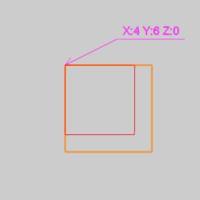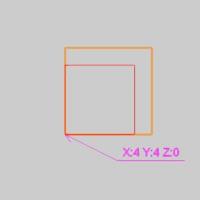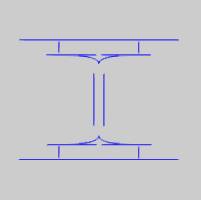 Scale
Scale
Introduction
This topic will explain the Scale function, and the options found in it. This topic will also give brief description of Dynamic Drawing, the Snap Increment function, will describe where to find the function, provide quick steps on how to use it, and provide links to related topics.
The Scale Function
The Scale function is used to scale (resize) wireframe or solid entities with separate scaling factors for each of the three coordinate axes.
Note: To use Scale on text entities, you must either create them using the Vectorize option, or you can use the Explode utility after creating non-vectorized text. Either method converts the text entities to lines and arcs so they can be used with Scale.
Dynamic Drawing
This function supports Dynamic Drawing which allows you to use a combination of sketching and data entry to create the entities. Prior to confirming the desired result in the function, an adjustable preview is visible. These previews can be modified using the sketch handles, data entry, or a combination of both. The benefit of Dynamic Drawing is that you can quickly utilized the sketch handles to adjust the size, placement, and, or, orientation to get the approximate result, and then use data entry to update to the exact values as needed.
|
Preview with Sketch Handles |
Final Entities |
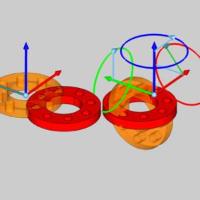
|

|
In the images above, we see the preview of the altered position / orientation of the entities which can be adjust with sketch handles, followed by those same entities after their positions / orientations are finalized.
Navigation
To open Scale, do one of the following:
-
In the Move group, of the Utilities ribbon, click
 Scale.
Scale.
The parameters display in the Data Entry Manager.
The Data Entry Parameters
- Hide Selected Geometry
 - With this check box cleared, the selected geometry will remain visible in the graphics area while utilizing the feature.
- With this check box cleared, the selected geometry will remain visible in the graphics area while utilizing the feature.  - With this check box selected, the selected geometry will not be visible in the graphics area while utilize the feature.
- With this check box selected, the selected geometry will not be visible in the graphics area while utilize the feature.
| Example Geometry | |

|
|
|
|
|

|
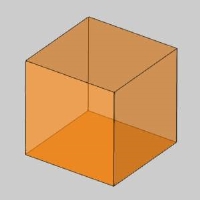
|
Scale Factors
The scale factor determines the ratio of scaling applied to the geometry. A value of 1.00 is equal to no scaling, 0.50 is equal to one half of the original size, and 2.00 is equal to twice the original size.
-
 Uniform Scale - applies the scale factor to all axes equally.
Uniform Scale - applies the scale factor to all axes equally.

|
Scale Factor - sets the scale to use on the selected geometry. |
-
 Non-Uniform Scale - allows for scaling factor to be applied to axes individually.
Non-Uniform Scale - allows for scaling factor to be applied to axes individually.

|
X - sets the scale in the X axis to use on the selected geometry. Y - sets the scale in the Y axis to use on the selected geometry. Z - sets the scale in the Z axis to use on the selected geometry. |
Scale Origin
-
 Geometry Center - applies the scale factor origin to the center of the selected geometry.
Geometry Center - applies the scale factor origin to the center of the selected geometry. 
Location Control
When the Scale Origin is set to Geometry Center, the Location Control group becomes available:
-
 Scale All Entities Together - keeps all selected geometry in their relative positions to each other.
Scale All Entities Together - keeps all selected geometry in their relative positions to each other. 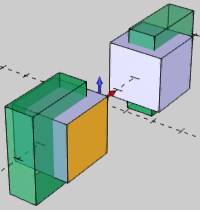
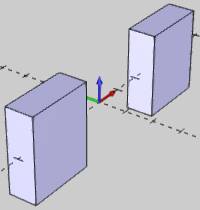
-
 Scale Each Entity Individually - scales all geometry individually, regardless of their positional relationship to each other.
Scale Each Entity Individually - scales all geometry individually, regardless of their positional relationship to each other. 
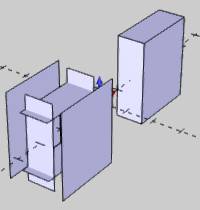
-
 Enter - allows each axis of the scale factor origin to be controlled individually.
Enter - allows each axis of the scale factor origin to be controlled individually.
|
X - defines the X axis of the Scale Origin. Y - defines the Y axis of the Scale Origin. Z - defines the Z axis of the Scale Origin. |
- OK - finalizes the function.
- Cancel - exits the function.
Quick Steps - Scale
- Open the function.
The Selected Geometry list automatically has focus. - Select the geometry to be scaled.
The geometry is added to the Selected Geometry list, and the preview automatically displays. - Define all the parameters.
Note: To use Scale on text entities, you must either create them using the Vectorize option, or you can use the Explode utility after creating non-vectorized text.
-
To finalize the scale, click OK.
If you want to scale more entities, update the Data Entry parameters and repeat this process as needed. -
To close the function, click Cancel.
If you selected solid or surface geometry to scale, a feature is added to the CAD Tree.
Example
A BobCAD file installed with the software can be opened to follow along with this example.
Part 1) Open the Example File
-
In the Quick Access Toolbar, click
 Open.
Open. -
Navigate to: C:\BobCAD-CAM Data\BobCAD-CAM V**\Examples, and select Nonuniform Scale Example.bbcd.
-
With Nonuniform Scale Example.bbcd displaying in the File Name box, click Open.
About the Example Geometry
The example file contains two cubes, one of which is a single solid body, and the other is unstitched meaning it is six separate surfaces (solid bodies). This is done to help illustrate the scaling options for the function.
Before opening the function, we use the CAD Tree to visualize the solid bodies in the graphics area.
-
In the Data-CAM Tree Manager, click the
 CAD Tree Manager tab.
CAD Tree Manager tab. -
Next to
 Solids,
click
Solids,
click  to expand the
folder.
to expand the
folder. -
Click anywhere in the graphics area, to give it key focus, and press S to turn off the Shaded view.
-
Click Solid 1 in the CAD Tree and notice the cube highlights in the graphics area.

-
Click each Solid item in the CAD Tree to highlight the separate surface bodies in the graphics area.

You can see that one cube is a single entity, and the other cube is six separate entities.
Part 2) Open Scale
To open Scale:
-
In the Move group, of the Utilities ribbon, click
 Scale.
Scale.
The parameters display in the Data Entry Manager.
Part 3) Using Scale
For this example, we select the geometry first to create the CAD preview. This allows us to view the result of the function before it is created.
-
Press S to turn on the Shaded view.
-
Press Ctrl+A to select all geometry in the graphics area.
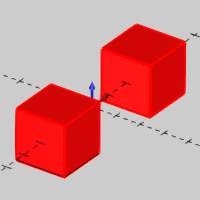
Click OK to create the CAD preview.
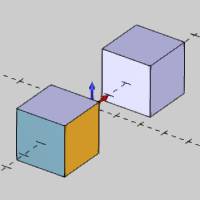
It appears as if there is no CAD preview,
because we have not yet defined a Scaling Factor (they are set to 1.00
which means no scaling).
-
In the Data Entry Manager under Scale Factor, double-click in the X box to select all the text, and type 0.750.
Press Tab to move to the Y box and update the CAD preview.
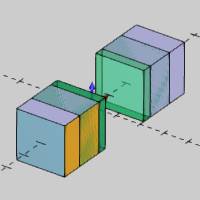
This setting scales the geometry to 75 percent of the original size in the X-axis only.
-
In the Y box, type 1.250 and press Tab.
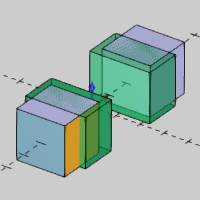
This setting scales the geometry to 125 percent of the original size in the Y-axis only.
-
In the Z box, type 1.500 and press Tab.

Note: When scaling 2D wireframe entities, only two of the Scale Factors can be used, based on the drawing plane. For example, changing the Z-axis scale factor has no effect on wireframe drawn in the XY plane.
Part 4) Using the Location Control Options
We have been using the default Location Control option, Scale All Entities Together. This treats all selected geometry as a single unit to which the scaling is applied. You may notice that the CAD preview shows the cubes are moving away from their original location as a result of the current Location Control option. Next we explore the Scale Each Entity Individually option.
-
Under Location Control, click Scale Each Entity Individually.

Notice the change in the CAD preview. You can see that the scaling is no longer moving the cubes away from their original location, because they are now being scaled as individual entities. You can also see that each surface of the unstitched cube is now also being scaled individually.
![]() Tip:
Tip:
Using the Scale All Entities Together option maintains the relationship between multiple entities when using scaling. This may be helpful when scaling wireframe shapes, or as in this example, a cube made of separate surfaces.
|
Original Shape |
Scale All Entities Together |
Scale Entities Individually |
|
|
|
|
Note that both Location Control options provide the same result when scaling a single entity.
-
Change the Location Control back to Scale All Entities Together.

-
To scale the entities as shown in the CAD preview, click OK.
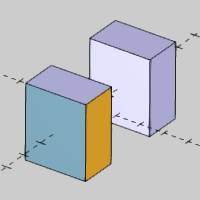
-
Click Cancel to close the Data Entry Manager.
Part 5) Modifying the Feature Using the CAD Tree
When you use Nonuniform Scale with solids, a feature is created and stored in the CAD Tree to allow for modification and more as explained in the CAD Tree. When you cancel the function, the CAD Tree Manager automatically displays. Notice the Nonuniform Scale feature in the CAD Tree.
For this part of the example, we decide that we want to scale each of the cubes individually. Next we use the CAD feature to change the geometry selection.
-
In the CAD Tree next to Nonuniform Scale, click
 to expand the feature.
to expand the feature. -
Right-click
 Geometry,
and click Re/Select.
Geometry,
and click Re/Select. -
Click the single-entity cube to remove it from the selection.


-
Press the Spacebar to confirm the selection.
Notice that the feature automatically rebuilds when confirming the selection.

Now that we are scaling each cube separately, they retain their original location (the center of the cube doesn't change).
-
You can now create another Scale feature to scale the other cube.
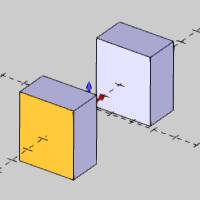
This concludes the example.
